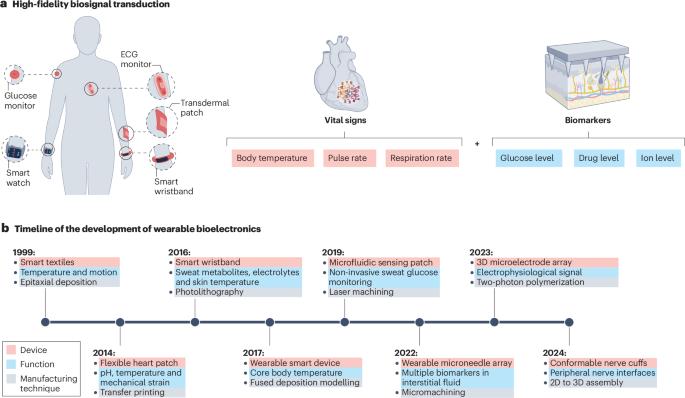Three-dimensional micro- and nanomanufacturing techniques for high-fidelity wearable bioelectronics
引用次数: 0
Abstract
High-fidelity wearable bioelectronics aims to establish seamless integration between electronic devices and biological systems to enable real-time health monitoring, disease diagnosis, and multimodal interaction. Central to this integration are the bio–electronic interfaces, which require conformal alignment and optimized electrical and mechanical properties to ensure stable and accurate signal acquisition. Traditional bioelectronic devices frequently fail to achieve good conformity at the microscale and nanoscale, lacking fabrication processes feasible for customized three-dimensional (3D) microstructures and nanostructures. In this Review, we discuss advances in 3D manufacturing technologies, focusing on those techniques that, enabling the fabrication of cross-scale, multimaterial structures, address key challenges in spatial complexity and mechanical mismatch at the bio–electronic interface. These innovations promote both long-term wearability and high-fidelity signal integrity. Interdisciplinary collaboration — particularly the integration of artificial intelligence — is essential for driving successful transformation in the field. Delivering cost-effective and scalable solutions for the fabrication of high-fidelity bioelectronic devices is crucial to realize their transformative potential in healthcare, human–machine interaction, and personalized medicine. Wearable bioelectronics integrates functional electronic devices with biological systems to enable real-time health monitoring and disease diagnosis. This Review explores advancements in three-dimensional manufacturing technologies for high-fidelity biosensors, addressing challenges related to fabrication, signal integrity, and long-term wearability.

高保真可穿戴生物电子学的三维微纳米制造技术
高保真可穿戴生物电子学旨在建立电子设备与生物系统之间的无缝集成,实现实时健康监测、疾病诊断和多模态交互。这种集成的核心是生物电子接口,它需要共形对准和优化的电气和机械性能,以确保稳定和准确的信号采集。传统的生物电子器件往往不能在微尺度和纳米尺度上达到良好的一致性,缺乏可定制的三维(3D)微结构和纳米结构的制造工艺。在这篇综述中,我们讨论了3D制造技术的进展,重点是那些能够制造跨尺度、多材料结构的技术,解决了生物电子界面空间复杂性和机械不匹配的关键挑战。这些创新提高了长期可穿戴性和高保真信号完整性。跨学科合作——尤其是人工智能的整合——对于推动该领域的成功转型至关重要。为制造高保真生物电子器件提供经济高效且可扩展的解决方案,对于实现其在医疗保健、人机交互和个性化医疗领域的变革潜力至关重要。可穿戴生物电子学将功能电子设备与生物系统集成在一起,实现实时健康监测和疾病诊断。本综述探讨了高保真生物传感器三维制造技术的进展,解决了与制造、信号完整性和长期可穿戴性相关的挑战。
本文章由计算机程序翻译,如有差异,请以英文原文为准。
求助全文
约1分钟内获得全文
求助全文

 求助内容:
求助内容: 应助结果提醒方式:
应助结果提醒方式:


